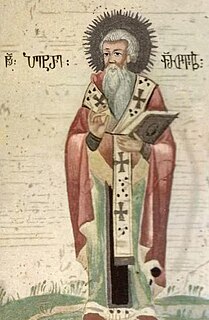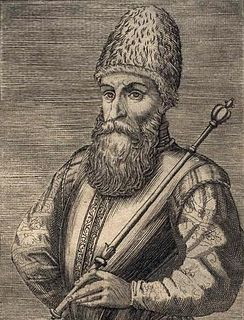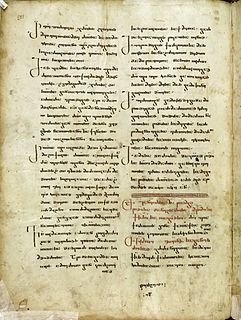This page is based on this
Wikipedia article Text is available under the
CC BY-SA 4.0 license; additional terms may apply.
Images, videos and audio are available under their respective licenses.

Peter the Iberian was a Georgian royal prince, theologian and philosopher who was a prominent figure in early Christianity and one of the founders of the Christian neoplatonism. Some have claimed that he is the author of the works written under the pen name Pseudo-Dionysius the Areopagite.

The Georgian scripts are the three writing systems used to write the Georgian language: Asomtavruli, Nuskhuri and Mkhedruli. Although the systems differ in appearance, all three are unicase, their letters share the same names and alphabetical order, and are written horizontally from left to right. Of the three scripts, Mkhedruli, once the civilian royal script of the Kingdom of Georgia and mostly used for the royal charters, is now the standard script for modern Georgian and its related Kartvelian languages, whereas Asomtavruli and Nuskhuri are used only by the Georgian Orthodox Church, in ceremonial religious texts and iconography.

Vakhtang I Gorgasali, of the Chosroid dynasty, was a king of Iberia, natively known as Kartli in the second half of the 5th and first quarter of the 6th century.

Prince Tornike Eristavi also known as John Tornikios or Tornikios was a retired Georgian general and monk who came to be better known as a founder of the formerly Georgian Orthodox Iviron Monastery on Mt Athos in the modern-day northeastern Greece.

Simon I the Great also known as Svimon (1537–1611), of the Bagrationi dynasty, was a Georgian king of Kartli from 1556 to 1569 and again from 1578 to 1599. His first tenure was marked by war against the Persian domination of Georgia. In 1569 he was captured by the Persians, and spent nine years in captivity. In 1578 he was released and reinstalled in Kartli. During this period, he fought as a Persian subject against the Ottoman domination of Georgia. In 1599 Simon I was captured by the Ottomans and died in captivity. During 1557 to 1569 he was known as Mahmud Khan and from 1578 to 1599 as Shahnavaz Khan

Jacob of Tsurtavi also known as Jacob the Priest was the 5th-century Georgian religious writer and priest from Tsurtavi, then the major town of Gogarene and the Lower Iberia.
Sumbat Davitis Dze, or Sumbat, son of David, in modern English transliteration, was the 11th-century Georgian chronicler who described in his The Life and Tale of the Bagratids the history of the Bagrationi dynasty of Georgia from the beginnings until c. 1030. The Georgian scholar Ekvtime Takaishvili has demonstrated that Sumbat belonged to that dynasty. The author is notable for his articulation of the Bagratid claim to be descended from the biblical King-Prophet David.

Anton I of Georgia ; 28 October [O.S. 17 October] 1720 – 12 March [O.S. 1 March] 1788), born as Teimuraz Bagrationi, was the Catholicos–Patriarch of the Georgian Orthodox Church in the period 1744–1755 and again in 1764–1788.
Basili Sabatsmindeli was a Georgian calligrapher, monk and writer of the 8th century.

Ioane Mesvete was a Georgian calligrapher who lived during the 11th century.
Iakob of Mtskheta was the second archbishop of the Georgian Orthodox Church in period of 363–375.
Ashot the Beautiful was a Georgian Bagratid prince of Tao-Klarjeti. Son of Adarnase II of Tao-Klarjeti. Died in 867.

Petre Aleksandres dze Bagrationi Gruzinsky was a Georgian prince (batonishvili), a descendant of the Kakhetian branch (Gruzinsky) of the Bagrationi dynasty, the former royal house of Georgia. Petre was the son of Prince Alexander Bagration-Gruzinsky.
Ramaz was a Georgian royal prince (batonishvili) of the Bagrationi dynasty.
Tamar was a Georgian princess of the royal Bagrationi dynasty.

Gabriel Patarai was a Georgian calligrapher of the 10th century.
Princess Latavri was a Georgian royal princess of the Bagrationi dynasty of Tao-Klarjeti branch.
Prince Stephanoz was a Georgian prince of royal Chosroid dynasty. Prince of Kakheti in 685–736.

Ananias is the Metropolitan of Manglisi and the Tetri-Tskaro of the Georgian Orthodox Church. He is a Candidate of Historical Sciences and is the author of more than forty scientific papers about the history of Georgia and the Georgian Church.
Ioane Minchkhi was a 10th-century Georgian hymnographer, contemporary to the king George II of Abkhazia. He is considered as author of the whole Sticheron part of the first Georgian “Lenten Triodion”. Ioane Minchkhi lived and worked at Mount Sinai. This explains the fact that a considerable part of his hymns are preserved in Sinaitic manuscripts. Ioane Minchkhi's four hymns are included in Iadgari of Mikael Modrekili (Tropologion) (978-988).










